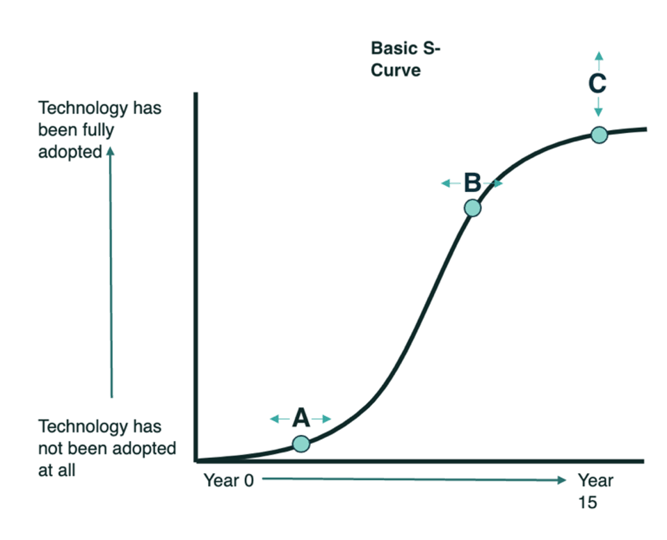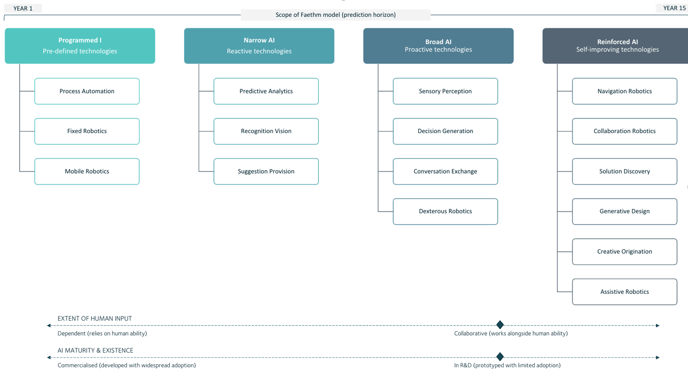Impact of Generative AI and Large Language Models (LLMs) advancements on the Faethm Technology Taxonomy
Understanding the Faethm Technology Taxonomy
The Faethm Technology Taxonomy is a human-centered classification of technology. We identified human abilities required for work and used these to construct a comprehensive taxonomy of technologies that could disrupt or enhance one or more of these abilities.

Each of the 16 technology classes represents a group of many technologies that directly impact work and are either available now or will be within the next 15 years. Every technology class is underpinned by a unique set of human abilities they can disrupt or enhance.
For example, Predictive Analytics has logic and learning but no perception, nor physical capabilities. Dexterous Robotics has logic, learning, comprehension, visual perception, and dexterity.
The technology progression from Programmed Intelligence through to Narrow AI, Broad AI Reinforced AI is representative of the development of cognitive abilities of logic through to comprehension and finally new idea generation with origination (Figure 2).
Where do Large Language models (LLMs) such as ChatGPT come into this?
The recent release of ChatGPT reflects a huge advancement in natural language generation. ChatGPT uses a transformer model to analyze user input and generate a custom response based on learnings derived from the vast amount of textual data it has been trained on.
This ability to create new content is mapped to the human work attribute “origination” in Table 1 above. It directly maps to the Faethm technology Solution Discovery but this ability also underpins a number of other technologies such as Collaborative Robotics and Assistive Robotics which combine “origination” with various perceptive and physical capabilities.
Once released, the multi-model version of GPT-4 with vision will extend this out to Generative Design and Creative Origin as well.
In their current form, these technologies are predominately augmenting rather than automating. While they can generate content instantly, a human reviewer is required for both the initial prompts, but also to review the output to ensure it is fit for purpose. Over time as these models improve and new products/services are built from these technologies, this could shift towards automation.
Modeling Technology adoption curves
Each technology is mapped then to a technology adoption curve. Technology adoption curves represent the average adoption of a technology over time. This is used to project how and when a technology will affect a given job. These curves are adjusted based on the country and industry of the job.
e.g. an Accountant in the finance industry located in Australia will be more likely to be impacted by technology than the equivalent Accountant located in Kenya.
We go through a research process that uses all input factors (cost/benefit, utility, organizational preparedness, operational context) to derive the three key metrics needed to plot an S-curve.
- Availability: When the technology will be commercially available affects point A or the point at which the curve can start to rise
- Speed: How fast technology will be adopted affects point B or the slope of the curve
- Extent: How widely technology will be adopted affects point C or the height that the curve reaches before flattening out

These curves are predicting technology trends up to 15 years in the future. The future is inherently uncertain, however, our approach aims to provide a probable scenario leveraging the data available at the time.
We are continuously reviewing and updating these curves based on technology changes. The recent advancements in LLMs such as ChatGPT have triggered a review of these curves.
